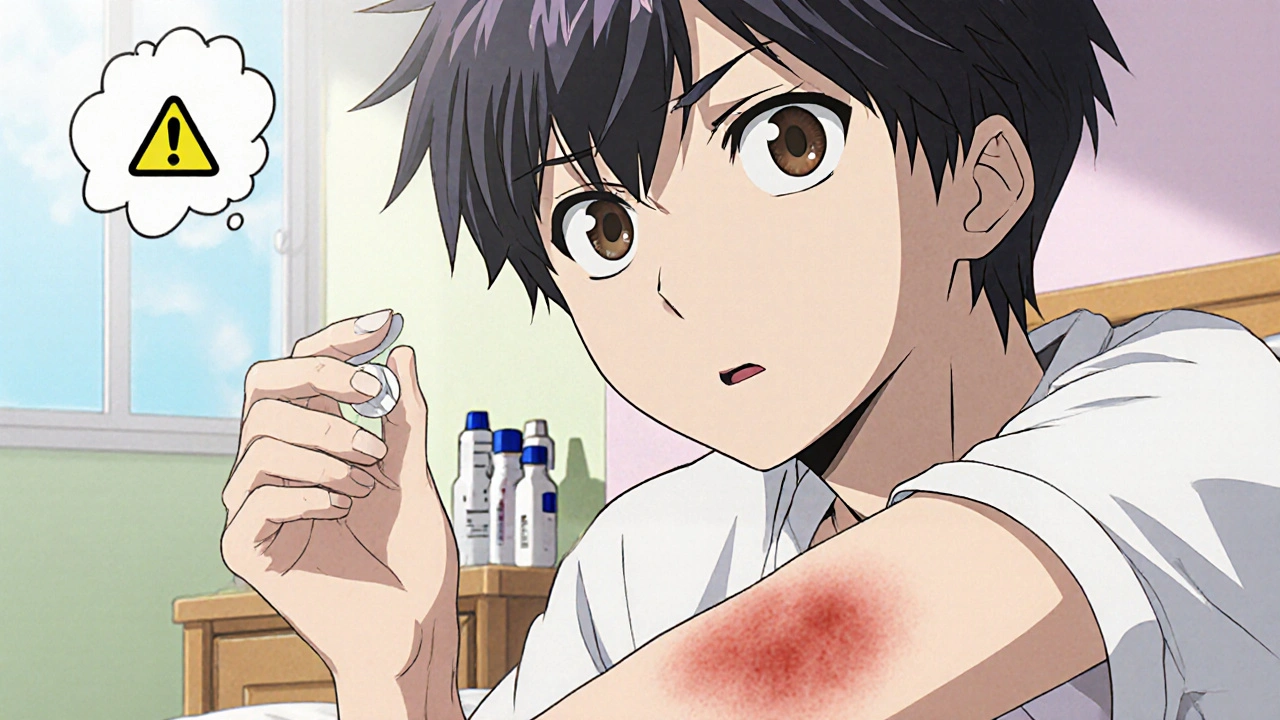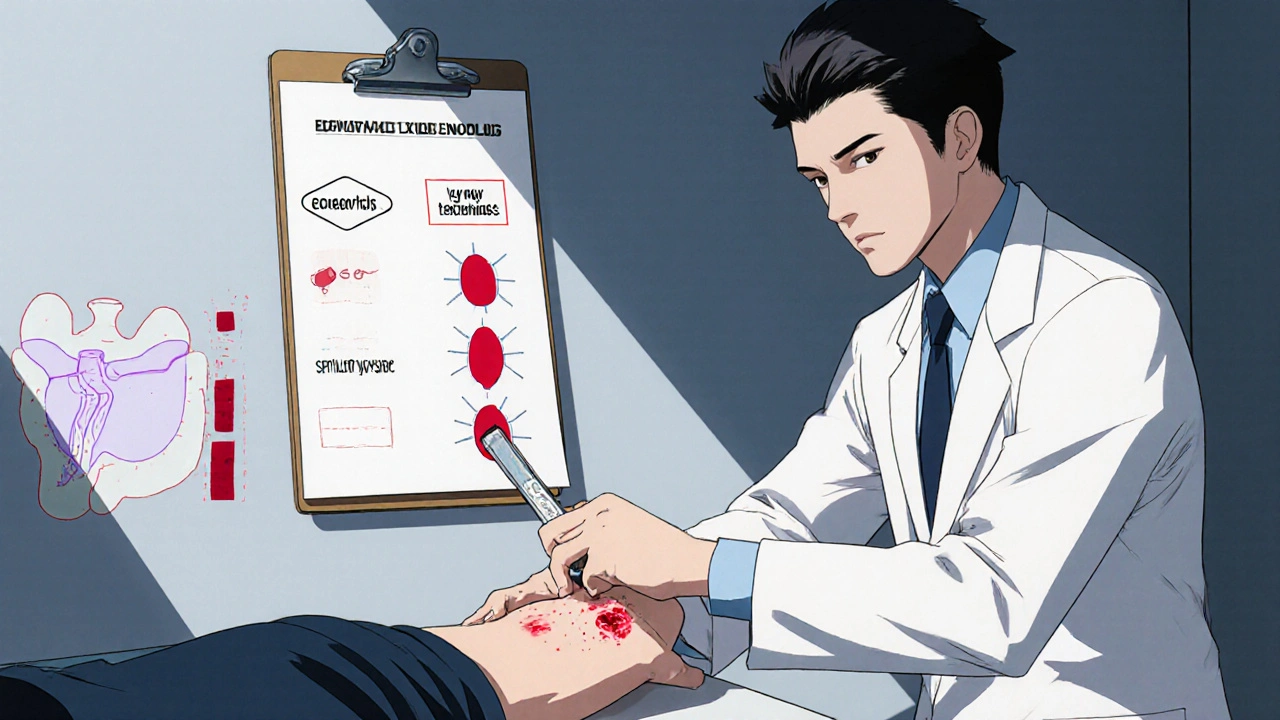
Methimazole Allergy Symptom Checker
Check Your Symptoms
This tool helps you assess whether your symptoms might indicate a Methimazole allergy. If you're experiencing severe symptoms, seek emergency care immediately.
Imagine you’ve been prescribed a pill to calm an overactive thyroid, and a few days later your skin starts itching, you develop a fever, or you feel short of breath. Those could be signs of a Methimazole allergy, a reaction that can range from mild rash to life‑threatening anaphylaxis. This guide walks you through what to watch for, how doctors pinpoint the problem, and what steps you can take to stay safe while still managing your thyroid.
What is Methimazole?
Methimazole is an oral thionamide medication used to treat hyperthyroidism, especially Graves disease. It works by blocking the thyroid’s ability to produce excess hormones, helping to normalize heart rate, weight, and energy levels.
First approved in the 1960s, methimazole remains the first‑line therapy in most guidelines because it’s more stable than older agents and has a lower risk of severe liver toxicity.
Why Do Allergic Reactions Happen?
Like any drug, methimazole can trigger the immune system. In some people, the body mistakenly sees the medicine as a harmful invader and launches a hypersensitivity response. This is called an antithyroid drug reaction. The reaction can be mediated by IgE antibodies (immediate type) or by T‑cell mechanisms (delayed type), leading to a spectrum of symptoms.
Typical Symptoms of a Methimazole Allergy
- Skin manifestations: red rash, hives (urticaria), or itchy papules that appear within hours to days after the dose.
- Respiratory signs: wheezing, shortness of breath, or throat tightness-classic clues for anaphylaxis.
- Fever and malaise: low‑grade fever, chills, or a general feeling of being unwell.
- Joint and muscle pain: arthralgia or myalgia may develop, sometimes accompanied by swelling.
- Gastro‑intestinal upset: nausea, vomiting, or abdominal cramping, though these are less specific.
Severe manifestations such as angio‑edema (swelling of lips or eyes) or a sudden drop in blood pressure require emergency care.

How Do Doctors Diagnose a Methimazole Allergy?
Diagnosis rests on a careful history and, when needed, targeted testing.
- Timeline correlation: clinicians ask when symptoms started relative to the first methimazole dose. A rash appearing within 7‑14 days is highly suspicious.
- Physical examination: the doctor looks for characteristic hives, wheals, or signs of systemic involvement.
- Laboratory tests: a complete blood count may reveal eosinophilia (high eosinophil count) in allergic reactions. Serum tryptase can be elevated in anaphylaxis.
- Skin prick or intradermal testing: performed by an allergist, these tests expose a tiny amount of the drug to the skin to see if a wheal forms. Positive results confirm IgE‑mediated hypersensitivity.
- Drug provocation test: in rare, controlled settings, a graded re‑introduction of methimazole under close monitoring can differentiate true allergy from other causes.
Because stopping an antithyroid drug abruptly can cause a rebound thyroid storm, the diagnostic process is usually coordinated with an endocrinologist.
Management Strategies Once an Allergy Is Confirmed
When a methimazole allergy is identified, the goal is two‑fold: stop the offending agent and keep thyroid hormone levels under control.
- Discontinue methimazole immediately: patients are instructed to stop the medication and keep a written note for pharmacists.
- Switch to an alternative antithyroid drug: Propylthiouracil (PTU) is the most common backup. While PTU carries its own risk profile (especially liver toxicity), it is less likely to cross‑react in methimazole‑allergic patients.
- Use symptomatic relief: beta‑blockers (e.g., propranolol) can control tremor and rapid heart rate while a new antithyroid drug takes effect.
- Administer corticosteroids: short courses of oral prednisone can blunt severe rash or airway inflammation.
- Desensitization protocols: in rare cases where methimazole is the only viable option (e.g., PTU contraindicated), allergists may perform a graded desensitization over 24‑48 hours, followed by careful monitoring.
- Consider definitive therapy: radioactive iodine ablation or thyroidectomy may become the preferred route if drug therapy is repeatedly limited by allergic reactions.
Comparing Methimazole and PTU for Allergic Patients
| Feature | Methimazole | Propylthiouracil (PTU) |
|---|---|---|
| Primary use | First‑line for Graves disease | Second‑line or alternative |
| Common allergic symptoms | Rash, urticaria, anaphylaxis | Rash, fever, rare anaphylaxis |
| Cross‑reactivity rate | Low (≈5‑10 % with PTU) | Low (≈5‑10 % with methimazole) |
| Major non‑allergic side‑effects | Agranulocytosis, hepatotoxicity (rare) | Hepatotoxicity (higher risk), agranulocytosis |
| Typical dosing | 5‑30 mg daily | 100‑300 mg daily in divided doses |
| Pregnancy safety | Category D, used when benefits outweigh risks | Category D, but avoided in first trimester |
For most patients who develop a methimazole allergy, PTU offers an effective bridge while the thyroid is being stabilized. However, clinicians weigh liver safety, especially in patients with pre‑existing hepatic issues.

Prevention and Monitoring Tips
- Baseline labs: before starting any thionamide, a CBC, liver panel, and renal function test set a reference point.
- Early symptom diary: patients keep a daily log of rash, breathing changes, or fever for the first month of therapy.
- Regular follow‑up: check‑ups every 2‑4 weeks during dose titration help catch reactions early.
- Educate caregivers: family members should know to call emergency services if swelling of the face or throat occurs.
- Drug alert card: a wallet‑size card listing the allergy and alternative medication prevents accidental re‑exposure.
By staying proactive, most allergic episodes can be identified before they become severe, allowing a swift switch to a safer regimen.
When to Seek Emergency Care
If you notice any of the following after taking methimazole, treat it as an emergency:
- Difficulty breathing, wheezing, or voice changes.
- Rapid swelling of lips, tongue, or throat.
- Dizziness, fainting, or a sudden drop in blood pressure.
- Severe hives covering large body areas.
Call 111 (New Zealand’s emergency number) or go to the nearest emergency department. Prompt administration of epinephrine can be lifesaving.
Frequently Asked Questions
Can I take a lower dose of methimazole if I’m allergic?
No. Allergic reactions are not dose‑dependent; even a tiny amount can trigger an IgE response. The safest move is to stop the drug entirely.
Is a rash always a sign of allergy?
Not always. Methimazole can also cause a non‑immune rash or a mild skin irritation. The key is timing, severity, and whether other allergic signs (fever, wheeze) appear.
How long does it take for symptoms to resolve after stopping methimazole?
Most mild rashes improve within 48‑72 hours. Severe reactions like anaphylaxis resolve as soon as emergency treatment is given. Thyroid control may take weeks, so an alternative drug is usually started right away.
Can PTU also cause an allergy?
Yes, PTU can trigger similar skin or respiratory reactions, but cross‑reactivity is uncommon. If you react to PTU, clinicians consider definitive therapies like radioactive iodine.
Is desensitization safe for everyone?
Desensitization is reserved for patients who have no viable alternatives and can be monitored in a hospital setting. It carries a risk of breakthrough reactions, so it’s not routine.
Understanding the signs, confirming the diagnosis, and having a clear action plan can keep you safe while you treat hyperthyroidism. If you suspect an allergy, talk to your endocrinology team right away.
Write a comment
Your email address will not be published.





6 Comments
Well, ain't this a melodramatic romp through endocrinology lore? The author drapes the whole methimazole saga in an overwrought veneer, as if a simple rash could be the climax of a gothic novel. Let's be real – the drug is just a chemical, not some cursed relic from the Dark Ages. Yet the prose reeks of hyperbole, sprinkling buzz‑words like "hypersensitivity" and "anaphylaxis" as if they were exotic spices. If you're looking for a clinical cheat‑sheet, you'll be left with a theatrical monologue instead. Grab a coffee, enjoy the drama, and maybe double‑check your pharmacy label.
Reading this guide feels like a moral lecture on self‑preservation – and rightly so. Ignoring allergic cues is tantamount to gambling with your own life, a negligence that borders on sin. The author wisely urges immediate cessation at the first hint of rash; any delay is an ethical breach. Moreover, the emphasis on emergency preparedness reflects a compassionate duty to protect the vulnerable. By cataloguing symptoms meticulously, the post empowers patients to act responsibly, turning passive sufferers into vigilant guardians of their health.
Let's cut through the fluff – methimazole and PTU have distinct pharmacodynamic signatures, and the table presented does a decent job, albeit with a dash of American bravado. First‑line therapy, as the article notes, indeed leans heavily on methimazole due to its more predictable pharmacokinetics. Cross‑reactivity remains low, but clinicians must still monitor eosinophil counts to preempt a sneaky hypersensitivity. Remember, agranulocytosis is a looming threat irrespective of allergic manifestations, so weekly CBCs are non‑negotiable. Finally, the suggestion of definitive therapy isn't a last resort; for many US patients, radioiodine is the pragmatic endpoint.
In contemplating the cascade of allergic manifestations, we encounter a profound intersection of biology and agency. The immune system, when misdirected, becomes a mirror reflecting our vulnerability, urging us to listen to its subtle warnings. By acknowledging the temporal correlation between dose initiation and symptom emergence, we honor the principle of causality that underpins scientific inquiry. Moreover, the recommendation to maintain a symptom diary transcends mere data collection; it cultivates mindful awareness, a practice beneficial far beyond pharmacovigilance. The strategic switch to propylthiouracil, while pragmatic, also embodies a philosophical flexibility – the willingness to adapt when confronted with unforeseen obstacles. Equally, the judicious use of corticosteroids illustrates the balance between mitigating harm and preserving physiological harmony. Desensitization protocols, though rarely employed, symbolize humanity's resolve to persevere in the face of adversity, albeit with measured caution. The ultimate recourse to definitive therapies, such as radioactive iodine or thyroidectomy, underscores a deeper truth: sometimes, resolution demands a decisive transformation rather than incremental adjustment. Each step delineated in the guide invites patients to become active partners in their care, fostering empowerment rather than passive compliance. In a broader sense, this collaborative model mirrors the Socratic ideal where knowledge emerges through dialogue and shared responsibility. Consequently, the management strategies outlined not only safeguard physiological stability but also nurture a resilient, informed self. Let us, therefore, internalize these lessons, recognizing that the path to wellness is as much an intellectual journey as a medical one. By integrating vigilant monitoring, adaptive therapy, and compassionate self‑advocacy, we construct a holistic framework capable of navigating the complexities of methimazole allergy with grace and precision.
Great insights above! 🌟 Switching to PTU can be a smooth transition if done right.
Just remember to keep your thyroid labs in check every 2‑3 weeks.
And don’t forget that a friendly reminder on your fridge can save you from a surprise flare‑up. 😊
Honestly, keep that allergy card in your wallet – it’s a lifesaver.